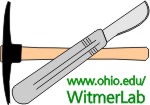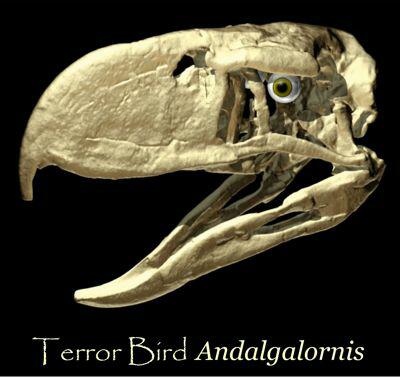- News & information
- About
- History
- George V. Voinovich
- George V. Voinovich Collection
- Calendar
- How to Find Us
- News
- Archives
- Photojournalism Fellowship Project
- Photo Essays
- Current Fellow
- Previous Fellows
- Reports and Publications
- Archives
- Students
- Prospective
- Center for Entrepreneurship
- Environmental Studies
- HTC/Voinovich School Scholars
- Master of Public Administration
- Current
- HTC/Voinovich School Scholars
- Center for Entrepreneurship
- Environmental Studies
- Master of Public Administration
- Alumni
- Contact
- School Leadership
- Strategic Partners Alliance
- Ohio University Public Affairs Advisory Committee
- Ohio University Public Affairs Advisory Committee
- Faculty and Fellows
- Faculty
- Visiting Professors
- Voinovich Fellows
- Professional Staff
| Lawrence M. Witmer,
PhD
|
 |
Mechanical analysis of feeding behavior in the
Terror Bird Andalgalornis |
 Predatory
feeding behavior in terror birds.
The common name for the extinct flightless phorusrhacids is
“terror bird,” an apt name indeed. Phorusrhacids radiated in
South America starting about 60 million years ago, eventually
migrating to North America before going extinct relatively
recently. No one has ever doubted that terror birds were
predators, but without modern-day counterparts, their lifestyles
have been obscure. A new study looked at the 6-million-year-old
skull of Andalgalornis
, a patagornithine terror bird
found in northwestern Argentina. CT scanning allowed a
multinational team to probe the inner anatomical structure of
its skull, as well as to perform advanced engineering analyses
of its skull biomechanics. The anatomical studies showed that
terror birds had also evolved very rigid heavy skulls. Bird
skulls generally are lightly built and very flexible with lots
of internal joints, but Andalgalornis
had evolutionarily
transformed all those flexible joints into strong rigid beams
with relatively thick bone. Loss of cranial kinesis (internal
flexibility) is rare in birds, and so in terror birds it must be
linked to increasing the rigidity of the skull particularly in
the fore-aft direction. An engineering method called
finite-element analysis allowed different feeding behaviors for Andalgalornis
to be simulated and evaluated. The
simulations told the same story as the anatomy: the skull was
well-adapted to drive the skull straight down, as well as to tug
straight back, but couldn’t tolerate thrashing the head from
side to side. The findings suggest that terror birds used their
powerful necks to jab prey with their rigid bills like a boxer,
using their speed and agility to repeatedly attack and retreat,
but being careful not to grapple with the prey too much which
might damage the tall narrow beak. Once killed by the axe-like
beak, the prey would be swallowed whole or dismembered by
grasping with the hooked beak and pulling straight back with the
nec
k.
Predatory
feeding behavior in terror birds.
The common name for the extinct flightless phorusrhacids is
“terror bird,” an apt name indeed. Phorusrhacids radiated in
South America starting about 60 million years ago, eventually
migrating to North America before going extinct relatively
recently. No one has ever doubted that terror birds were
predators, but without modern-day counterparts, their lifestyles
have been obscure. A new study looked at the 6-million-year-old
skull of Andalgalornis
, a patagornithine terror bird
found in northwestern Argentina. CT scanning allowed a
multinational team to probe the inner anatomical structure of
its skull, as well as to perform advanced engineering analyses
of its skull biomechanics. The anatomical studies showed that
terror birds had also evolved very rigid heavy skulls. Bird
skulls generally are lightly built and very flexible with lots
of internal joints, but Andalgalornis
had evolutionarily
transformed all those flexible joints into strong rigid beams
with relatively thick bone. Loss of cranial kinesis (internal
flexibility) is rare in birds, and so in terror birds it must be
linked to increasing the rigidity of the skull particularly in
the fore-aft direction. An engineering method called
finite-element analysis allowed different feeding behaviors for Andalgalornis
to be simulated and evaluated. The
simulations told the same story as the anatomy: the skull was
well-adapted to drive the skull straight down, as well as to tug
straight back, but couldn’t tolerate thrashing the head from
side to side. The findings suggest that terror birds used their
powerful necks to jab prey with their rigid bills like a boxer,
using their speed and agility to repeatedly attack and retreat,
but being careful not to grapple with the prey too much which
might damage the tall narrow beak. Once killed by the axe-like
beak, the prey would be swallowed whole or dismembered by
grasping with the hooked beak and pulling straight back with the
nec
k.
• Download a PDF of the published article:
This project was funded by grants from the National Science Foundation .
Contact Information:
(740) 593–9381 | Building 21, The Ridges
Ohio University Contact Information:
Ohio University | Athens OH 45701 | 740.593.1000 ADA Compliance | © 2018 Ohio University . All rights reserved.


















